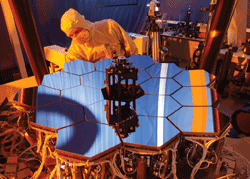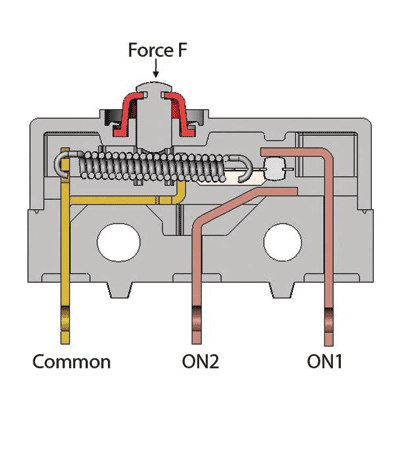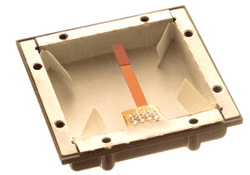MEMS microshutters for a new space telescope
By Eric Lyness
Mink Hollow Systems, Ashton, MD
http://www.minkhollowsystems.com
Knute Ray
NASA Goddard Space Flight Center Greenbelt, MD
http://www.nasa.gov/centers/goddard/home/index.html
David Rapchun
Global Science and Technology
Greenbelt, MD
The James Webb Space Telescope (JWST) is the next big telescope at NASA. More ambitious than the Hubble Space Telescope, its predecessor, the JWST will be placed by NASA at a stable Lagrange point approximately one million miles from the earth. This telescope is the next stepping stone toward understanding the universe and studying the Big Bang theory at NASA. The next major project milestone is the overall Critical Design Review. JWST should launch in the next decade… http://www.nxtbook.com/nxtbooks/hearst/projectmems_201005/index.php?startid=5

For testing the microshutter design, NASA used a fully functional, 1/6th scale model of the JWST mirror in an optics test bed.
The limiting factors of electromechanical switches
By Markus Afolter
Wilbrecht LEDCO, St. Paul, MN
http://www.wilbrechtledco.com
From pharmaceutical to oil and petrochemical industries and many more, process control greatly depends on two physical variables: temperature and pressure. While a wide range of sensors are available for temperature and pressure control in process automation applications, the simplest solution is often an electromechanical switch… http://www.nxtbook.com/nxtbooks/hearst/projectmems_201005/index.php?startid=9

Snap-action switches are designed to change over from their initial ON1 circuit to their ON2 circuit when the actuating force is higher than the internal force
Applying piezoelectric film in electronic designs
By Jon Dent
Digi-Key,Thief River Falls, MN
http://www.digikey.com
Pete Smith
Measurement Specialties, Hampton, VA
http://www.meas-spec.com
Piezoelectric film is a transducer technology with unique capabilities and design advantages. It can produce voltage in proportion to compressive or tensile mechanical stress or strain, making it an ideal dynamic strain gage. Lightweight and flexible, piezoelectric film can serve as a highly reliable low-cost alternative to more expensive sensors, either as an accelerometer or dynamic switch element, in applications where space is at a premium… http://www.nxtbook.com/nxtbooks/hearst/projectmems_201005/index.php?startid=13

A piezo anti-tamper film is applied to the inside of a module housing.
Shifting into high gear
In last October’s viewpoint, we wrote about the move away from using a monolithic silicon manufacturing approach to developing MEMS devices, quoting from an article in the MEMS Industry Association blog by St. J Dixon-Warren of Chipworks about Analog Devices abandoning its integrated iMEMS technology. At that time, we wrote, “So for now, it looks like the road ahead is paved with multiple-IC MEMS devices.” Half a year later, we’re happy to report that road construction is well underway and that MEMS designs using multiple ICs have shifted into high gear.
Roger Grace of Roger Grace Associates points to no fewer than 10 major designs that have taken a multichip approach in his article “Thinking outside the chip for MEMS design success,” which appeared in the February 2010 issue of Electronic Products . For example, he points to Crossbow Technologies’ FAA-certified MEMS-based attitude control system for general aviation, which integrates three MEMS accelerometers and gyros with a DSP chip that incorporates flash and E2 memory functions as well as Kollman filter algorithms.
Grace notes that, “MEMS devices have been available for almost 50 years. Pressure sensors, accelerometers, gyros, and displacement sensors have been popularly used as system components for a wide spectrum of applications in the automotive, aerospace, industrial, medical, and (most recently) consumer markets. However, only until recently has there been an epiphany in the MEMS community that has led to ‘thinking outside the MEMS chip’ and considering all other elements/functionalities required to create an optimum systems solution.”
Grace has been a major proponent for rethinking how MEMS systems should be designed, providing technical guidance to the industry on how to develop marketable products: MEMS systems that can get the job done for a price that people can afford. In the series of articles he’s preparing for Electronic Products , all aspects of MEMS development — from design for manufacturing through testing to final packaging—are being shifting into high gear examined from a fresh angle.
Considering all the new capabilities designers want to add to their end products, it’s obvious that there is a penned up demand for MEMS devices that can perform new sensing and energy harvesting feats. It’s clearly a situation in which “thinking outside the MEMS chip” will pay off.
Richard ComerfordFor more on Project MEMs, visit www.electronicproducts.com/projectmems
Advertisement
Learn more about Electronic Products Magazine





